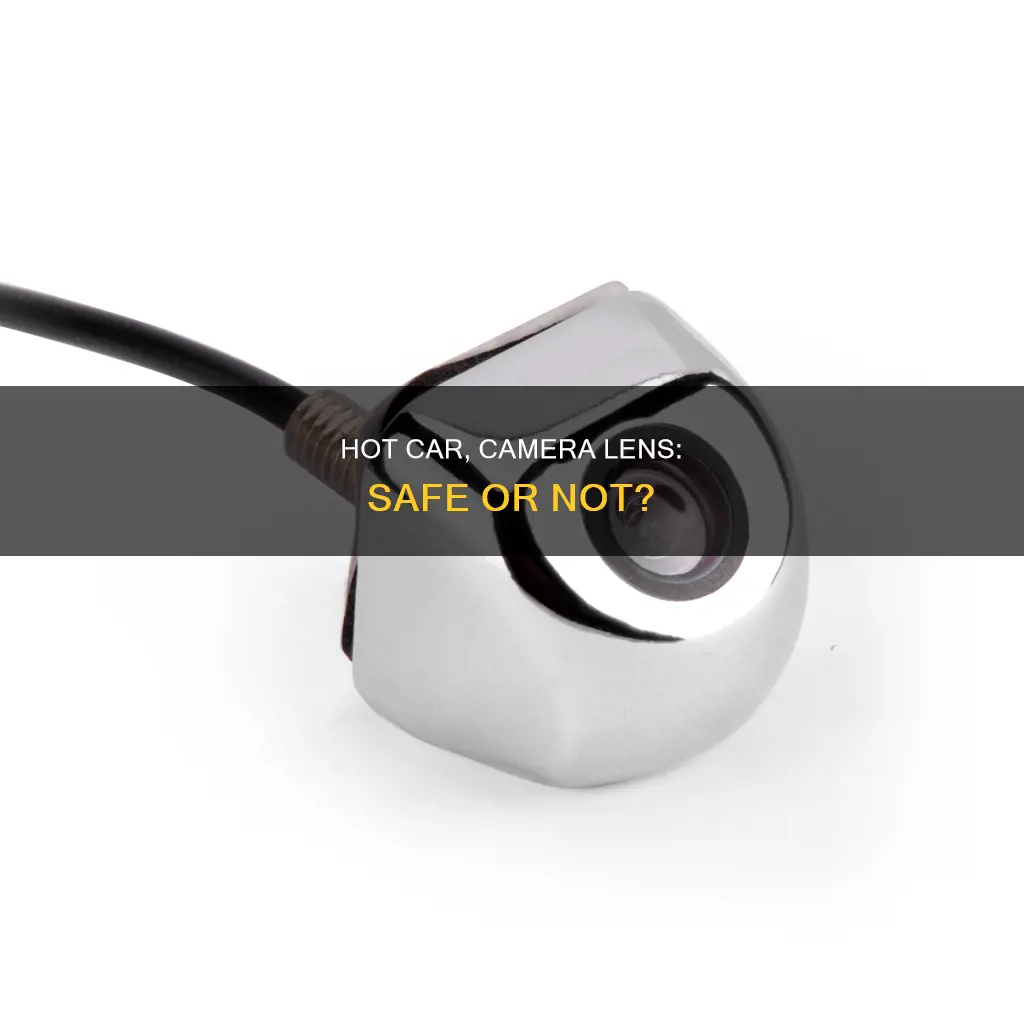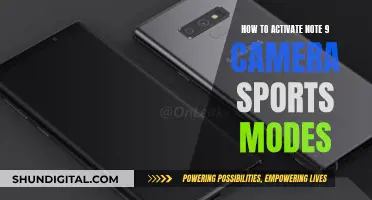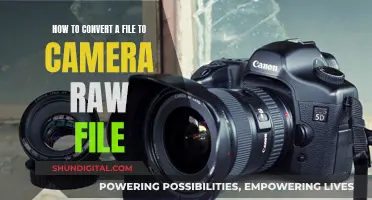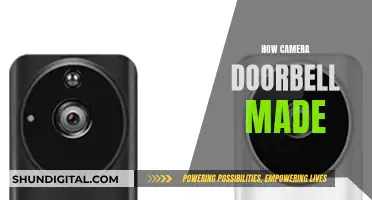
Leaving camera equipment in a hot car is generally not recommended, as temperatures can rise to 70°C and above, which can damage electronics and other components. However, some photographers have shared their experiences of leaving their gear in hot cars for short periods of time without any issues. It is advised to store the equipment in the trunk, away from direct sunlight, and to take sensible precautions to avoid extreme heat exposure.
| Characteristics | Values |
|---|---|
| Maximum recommended storage temperature | 50°C/122°F |
| Maximum temperature in a car | 160°F/71°C |
| Maximum recommended operating temperature | 45°C/113°F |
| Maximum operating temperature | 50°C/122°F |
| Temperature in the trunk | 105-110°F/40-45°C |
| Temperature in the car cabin | 180°F/80°C |
| Temperature in the car cabin with a white paint | 130°F/55°C |
| Temperature in the car cabin with a black paint | 160°F/71°C |
What You'll Learn

Camera gear can be left in the trunk of a car
To protect your camera gear from the heat, always store it in a protective bag, backpack, or case, and keep it out of direct sunlight. If possible, cover it with a blanket or place it in a cooler bag to provide additional insulation. It's also a good idea to allow your gear to cool down before removing it from its case and using it, and to protect it from condensation during this transition period.
In addition to the heat, there are other risks to consider when leaving camera gear in your car. One concern is theft, especially in tourist areas. Another issue is humidity, which can cause condensation and damage your equipment. To mitigate this risk, consider using desiccant packs to absorb moisture.
By taking these precautions, you can minimise the risk of damage to your camera gear when leaving it in the trunk of your car. However, it's always best to avoid leaving valuable equipment unattended in a vehicle if possible.
Are 360-Degree Car Cameras Necessary for Road Safety?
You may want to see also

Cameras should be stored in a bag or protective case
Cameras should always be stored in a bag or protective case to ensure their safety and longevity. Leaving a camera in a hot car can cause damage to its internal components, and the exterior finish may also fade due to prolonged exposure to UV rays. By storing your camera in a bag or case, you can protect it from extreme temperatures, direct sunlight, and potential theft.
When choosing a camera bag, look for one with comfortable shoulder straps that are adjustable to reduce strain and fatigue. Additionally, a well-designed camera bag will have a padded compartment to protect your camera and lenses from bumps and scratches. Dividers within the bag allow for customizable compartments to fit your specific gear, ensuring everything stays in place and is easily accessible. Some camera bags also offer dedicated storage for items like tripods or laptops.
It is also essential to consider the material and build quality of the bag. Opt for high-quality materials such as nylon, canvas, or leather, which are known for their strength and resistance to wear and tear. The bag should have reinforced stitching and sturdy zippers to withstand daily use. Waterproofing your camera bag is also crucial to protect your equipment from moisture and humidity.
For added protection, consider using protective wraps for your camera and lenses. These wraps are made from soft, padded material that shields your gear from scratches, dust, and impacts. They are lightweight and can be easily stored in your camera bag when not in use.
When storing your camera bag, keep it in a dry and cool place to prevent moisture damage and extreme temperatures that can harm your equipment. Avoid direct sunlight, and hang or store your bag off the ground to prevent any potential damage from spills or accidents.
By investing in a high-quality camera bag and following proper storage practices, you can ensure the safety and longevity of your camera equipment.
Side Cameras on Cop Cars: Are They a Thing?
You may want to see also

Cameras should be kept out of direct sunlight
Cameras are delicate pieces of equipment and should be handled with care. Leaving a camera in a hot car can cause damage to its internal components. The inside of a car can get very hot during the summertime, with temperatures soaring to over 120°F. This is due to the energy from the sun being trapped inside the vehicle. While the rated temperature of most cameras is between 32°F and 104°F, leaving a camera in direct sunlight can cause the temperature to rise above the recommended threshold.
Direct sunlight can also cause long-term damage to the exterior finish of a camera, fading and weakening the materials over time. Additionally, the sensors in cameras are very heat sensitive, and prolonged exposure to high temperatures can affect their performance. It is important to keep cameras out of direct sunlight to prevent overheating and potential damage.
When storing a camera in a car, it is recommended to keep it in a separate trunk compartment, which will stay much closer to the ambient air temperature. Placing the camera in a protective bag or case can also help to insulate it from the heat and keep it safe from prying eyes. Keeping the camera covered and out of direct sunlight can help to mitigate the risks associated with leaving it in a hot car.
It is also crucial to allow the camera to cool down before use if it has been exposed to extreme temperatures. Condensation can form on the camera's components during the transition from a hot to a cold environment, so it is important to protect it with a bag or case during this time. By taking these precautions, photographers can help ensure the longevity and proper functioning of their camera equipment.
Surveillance in Cafes: Are You Being Watched?
You may want to see also

Temperatures in cars can reach 70°C
Leaving camera equipment in a hot car can affect some of its most delicate parts. If left in direct sunlight, long-term exposure to UV rays can also fade the exterior finish and cause some materials to become weak and brittle. Most cameras are rated for temperatures between 0 and 40°C (32 to 104°F), and while they may not be immediately damaged by exceeding this range, parts that have not been tested for extreme heat could eventually suffer damage.
To minimise the risk of damage to camera equipment, it is recommended to keep the gear out of direct sunlight, in a well-ventilated area, and to allow it to cool down before use. Some suggestions include storing it under a seat, in a decent bag, or in the trunk, as these areas tend to be cooler. It is also important to consider the risk of theft when leaving valuable equipment in a car.
Charging Olympus Stylus Tough Camera: A Step-by-Step Guide
You may want to see also

Cameras should be kept with the user to avoid theft
Leaving a camera in a hot car can cause damage to its most delicate parts. Long-term exposure to UV can also cause the exterior finish to fade and some materials to become weak and brittle. The inside of a car can get very hot during the summertime, and the lack of airflow doesn't allow the heat to dissipate.
However, the more pressing issue is the risk of theft. Criminals tend to target items that are left unattended in vehicles, and cameras are no exception. By keeping your camera with you, you significantly reduce the risk of it being stolen. Here are some additional tips to help prevent theft and keep your camera safe:
- Use a camera bag or protective case to keep your camera discreet and protected when you're on the move.
- Consider investing in a locking theft-resistant bag or case that can be secured to the inside of your car when you need to leave your camera unattended for short periods.
- Be cautious when leaving your camera in a vehicle, even for a short time. If possible, keep it out of direct sunlight and cover it with something to make it less visible to potential thieves.
- Keep your camera insured. In the unfortunate event of theft, having insurance can provide some financial relief.
- Utilise security features such as password protection and encryption for your camera feeds to prevent unauthorised access and protect your privacy.
- Regularly back up your photos and footage to a secure location, such as cloud storage or an off-site physical storage facility. This ensures that even if your camera is stolen, you won't lose your precious memories.
- Be vigilant and aware of your surroundings, especially when travelling with your camera. Keep it securely by your side and avoid leaving it unattended in public places.
Reviving Your Kodak Z185: Refreshing the Battery Life
You may want to see also
Frequently asked questions
No. The majority of cameras are rated for temperatures between 0 and 40°C, which is 32°F to 104°F. It will not immediately get damaged for exceeding the maximum temperature but it eventually could as parts are not tested for such extreme heat.
If you have to leave your camera in the car, it is recommended to store it in the trunk of the car, which will be much closer to the ambient air temperature and hidden from thieves. You can also put sunshades on the windows, leave the windows open a crack, or cover the camera with a towel to avoid direct sunlight.
Heat can affect some of the most delicate parts of your camera. Long-term exposure to UV can also fade the exterior finish and cause some materials to become weak and brittle. Heat can also melt the grease used to lubricate the aperture blades, which can cause the aperture to not stop down properly.







